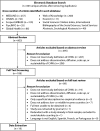Community health workers in low- and middle-income countries: what do we know about scaling up and sustainability?
- PMID: 23678926
- PMCID: PMC3682607
- DOI: 10.2105/AJPH.2012.301102
Community health workers in low- and middle-income countries: what do we know about scaling up and sustainability?
Abstract
Objectives: We sought to provide a systematic review of the determinants of success in scaling up and sustaining community health worker (CHW) programs in low- and middle-income countries (LMICs).
Methods: We searched 11 electronic databases for academic literature published through December 2010 (n = 603 articles). Two independent reviewers applied exclusion criteria to identify articles that provided empirical evidence about the scale-up or sustainability of CHW programs in LMICs, then extracted data from each article by using a standardized form. We analyzed the resulting data for determinants and themes through iterated categorization.
Results: The final sample of articles (n = 19) present data on CHW programs in 16 countries. We identified 23 enabling factors and 15 barriers to scale-up and sustainability, which were grouped into 3 thematic categories: program design and management, community fit, and integration with the broader environment.
Conclusions: Scaling up and sustaining CHW programs in LMICs requires effective program design and management, including adequate training, supervision, motivation, and funding; acceptability of the program to the communities served; and securing support for the program from political leaders and other health care providers.
Figures
References
-
- Bhattacharyya K, Winch P, LeBan K, Tien M. Community Health Worker Incentives and Disincentives: How They Affect Motivation, Retention, and Sustainability. Arlington, VA: Basic Support for Institutionalizing Child Survival Project (BASICS II) for the United States Agency for International Development; 2001.
-
- Bhutta ZA, Lassi ZS, Pariyo G, Huicho L. Global Experience of Community Health Workers for Delivery of Health Related Millennium Development Goals: A Systematic Review, Country Case Studies, and Recommendations for Integration into National Health Systems. Geneva, Switzerland: Global Health Workforce Alliance and World Health Organization; 2010.
-
- Haines A, Sanders D, Lehmann U et al. Achieving child survival goals: potential contributions of community health workers. Lancet. 2007;369(9579):2121–2131. - PubMed
Publication types
MeSH terms
LinkOut - more resources
Full Text Sources
Other Literature Sources


